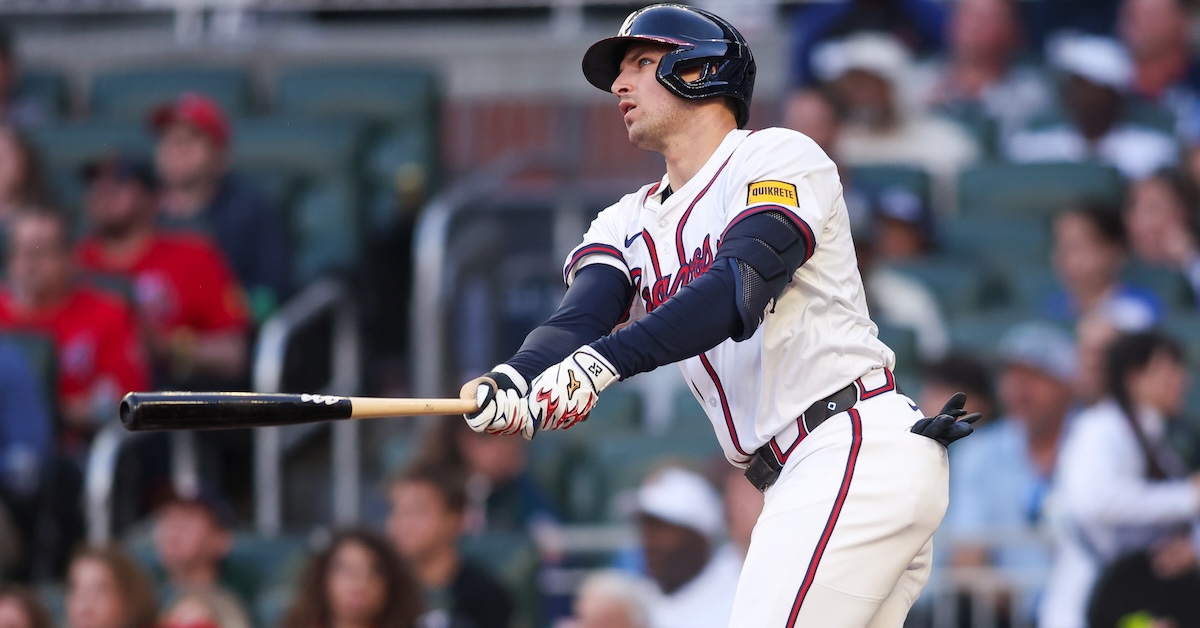Austin Riley Addresses His 2017 FanGraphs Scouting Report
Conservatively ranked as a promising-but-raw teenager, the Braves third baseman has developed into a top-notch slugger.


Austin Riley was relatively raw when our 2017 Atlanta Braves Top Prospects list was published in February of that year. Six weeks short of his 20th birthday, he was coming off of a Low-A season in which he logged 20 home runs and a 124 wRC+, but also fanned 147 times. With lingering concerns about both his contact profile and conditioning, Eric Longenhagen conservatively ranked Riley no. 28 in a then-strong Atlanta system.
Riley has obviously gone on to have a highly successful career. Since debuting with the Braves in May 2019, Riley has put up a 124 wRC+ and 19.9 WAR across parts of seven seasons, slugged 30-plus homers in three different years, and made a pair of All-Star teams. A mainstay in the middle of Atlanta’s lineup, the 41st-overall pick in the 2015 draft out Southaven, Mississippi’s DeSoto Central High School has developed into one of the senior circuit’s top sluggers.
What did Riley’s 2017 FanGraphs scouting report look like? Moreover, what does he think about it all these years later? Wanting to find out I shared some of what our lead prospect analyst wrote and asked Riley to respond to it.
———
“Riley began the year struggling with any sort of velocity and then improved the timing of his footwork, quieted his hands and started hitting. Late in the year, he was turning on plus velocity.”
“Very accurate,” Riley said. “Coming out of high school, I hadn’t seen velo a lot, and I kind of had a lot going on with my swing. I needed to make some adjustments. Being a bigger guy, a power guy, it was kind of, ‘All I have to do is touch the ball, get a barrel to the ball.’ It was one of my first steps in learning how to shorten everything up and just get a barrel to it. From there, good things happen.”
“He has plus raw power (at least) and has improved his body composition since high school (when he was a heavy 230). But at just 19, with some general stiffness to his actions, Riley is pretty likely to kick over to first base as he matures.”
“Not going to happen,” the sculpted third sacker opined. “But yeah, I’ve talked a little bit about it. My diet wasn’t the best. I was basically a college guy and liked to have my fun in the offseason; I didn’t take care of my body like I should have. Being a bigger guy at third you have to be able to move some, and I definitely learned some lessons from that.”
“The adjustments he made last year were encouraging, but reports from late in the year indicate some vulnerability on the outer half.”
“Outer half of the plate, right?” Riley replied. “I think a lot of that probably stemmed from the offspeed stuff. I had a ton of strikeouts on that. A lot of it, like [the report] said, was just trying to catch up to velo [with a] long swing. It was a challenge to get to the fastball and also react to the offspeed. I still swing at it now and again, but it’s gotten a little better.”
“He was up to 94 on the mound in high school.”
“Not many teams wanted me as a position player,” Riley recalled. “More people in the draft wanted me as a pitcher. But I just loved to hit — hit and play every day. I took a chance on myself. If I was going to do this — make a career out of [baseball] — I wanted to do something I wanted to do. My arm hurt all the time when I was pitching. It was never fun when I pitched, and I wanted to do something fun. I ended up backing out of the draft as a pitcher and just going in as a position player. I let people know, ‘Hey, if you’re going to draft me as a pitcher, I’m going to go to Mississippi State.’ I told them that I just wanted to play the infield and hit.
“I could be wrong, because it’s so long ago and kind of blurry, but I want to say it was Kansas City, the Brewers, and maybe the Cubs [who especially liked him on the mound]. The Braves really liked me as a hitter. While most teams didn’t want me as a hitter, they did. I appreciated that.”
——
Previous “Old Scouting Reports Revisited” interviews can be found through these links: Cody Bellinger, Matthew Boyd, Dylan Cease, Matt Chapman, Erick Fedde, Kyle Freeland, Lucas Giolito, Randal Grichuk, Ian Happ, Jeff Hoffman, Matthew Liberatore, Sean Newcomb, Bailey Ober, Max Scherzer, Marcus Semien.









